I've been on what can only be described as an incredible journey … the field camp of AGO 2. Bob Melville - AGO Team Leader, Andy Stillinger - Project Engineer, Gil Jeffer - Research Scientist, Marc Ankenbauer - Field Coordinator, and I spent eight days on the East Antarctic Plateau … 300 miles from anything and anyone. Living in such close quarters you not only learn a lot from each other, you learn a lot about each other. And one thing I learned is that I wouldn't hesitate for a minute to work with any of them again. Regardless of whether or not things were going according to plan, the five of us worked with and for each other, maintaining a good sense of humor along the way. And that's important because out in the field, these are the only people you have to depend on. Other than the Iridium phone, there's no escape, and no contact with the outside world.
So, let's meet the team and learn about their role(s) in the project, and what lead them to work in Antarctica exploring and supporting Space Weather Science!
AGO Project electrical engineer Andy Stillinger explains the new AGO power management system being installed, and what got him interested in engineering. http://youtu.be/l7c9DOVx2xY
Bob Melville discusses the Automatic Geophysical Observatories in Antarctica, the importance of Space Weather, and what got him interested in science and engineering. http://youtu.be/s6Y9b2DHJOw
Marc Ankenbauer discusses his role with the Automatic Geophysical ObservatoryA location used for observing terrestrial and/or celestial events. Project (AGO), and the career path that brought him to Antarctica and the South Pole. http://youtu.be/NRTgQUQv1Ic
Gil Jeffer describes his roll with the AGO Project in Antarctica, and what got him interested in science. http://youtu.be/aKilJbPdAQ8
AGO 2
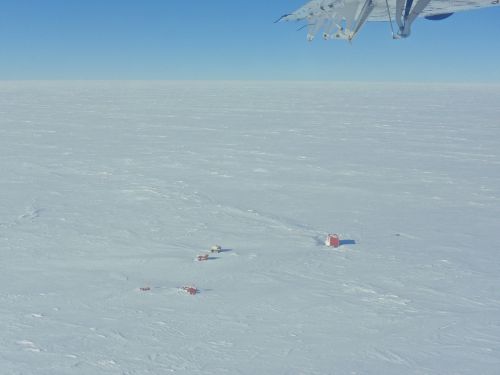
There are a total of five active Automatic Geophysical ObservatoryA location used for observing terrestrial and/or celestial events. (AGO) sites throughout Antarctica, and they are giving scientists a better understanding of the interaction between the Earth's magnetic field and the sun. Every 11 years activity increases on the sun. We see significantly more sun spots during this time and more coronal mass ejections (CME). CME are massive eruptions off the surface of the sun that send streams of charged particles toward the Earth. When the particles slam into Earth's magnetic field they spiral down the magnetic field lines and create an electrical current in the Earth's upper atmosphere that is often seen as spectacular Northern or Southern Lights (aura). If the CME is strong enough there's not only the potential for the spectacular display of lights in the night sky, but this stream of charged particles could disrupt or even destroy satellites orbiting the Earth. Our society has become dependent on satellites for communication, weather prediction, GPSA Global Positioning System (GPS) is a satellite-based navigation system used to track the location or position of objects on the Earth’s surface., and national security. In addition these CME events could even knock-out parts of the power grid here in the US and elsewhere in the World causing electrical blackouts that could potentially last for months.
It's hoped that one day the science being conducted by the AGO Project will help us better predict CME events that cause a significant threat to human activity here on Earth, giving us the necessary time to react (e.g. put satellites into safe-mode before the height of the solar storm hits) to protect satellites as well as the power grid system here on Earth.
Learn more about Space Weather and this potential threat at http://www.spaceweather.com
Day 1 - Setting up Field Camp at AGO 2
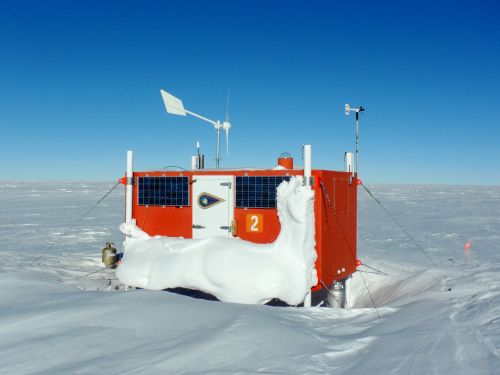
When we arrived at the AGO 2 site things were in a little better shape than we had anticipated. These structures are 8' X 16' and contain the instruments that record activity between the Sun and the Earth's magnetic field, and the remote power systems. AGO sites usually have two magnetometers measuring fluctuations in Earth's magnetic field, instruments that measure differences in radio emissions coming through the Earth's ionosphere, an all-sky camera to monitor aurora, and instruments that measure local weather conditions.
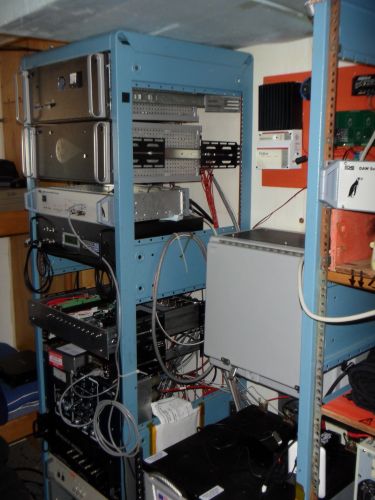
The primary task for Day 1 was to set up camp. I worked with Marc Ankenbauer and Gil to construct Mr. Scott … the Antarctic outhouse, set up 5 sleep tents, make water out of snow, and organize food and equipment brought in by the Twin OtterA highly maneuverable utility aircraft developed by de Havilland Canada. It can be flown slowly and in tight circles, and is designed for 20 passengers, short takeoffs and landings, and often used for cargo, passengers, and as a science platform. airplane. Project Engineer Andy Stillinger and Project Leader Bob Melville spent the day accessing the current state of the instruments and power system.


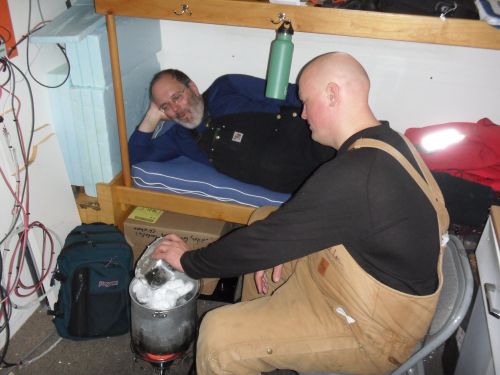

Day 2 - Digging Snow
I spent a lot of time digging snow on day two. Things get drifted over here pretty quickly. At each AGO site barrels full of airplane fuel are stored so that if needed incoming aircraft can refuel. At the AGO 2 site 25 barrels of fuel had to be dug out and moved up out of the snowdrift. And that was quite the job considering each barrel weighs more than 400 pounds.
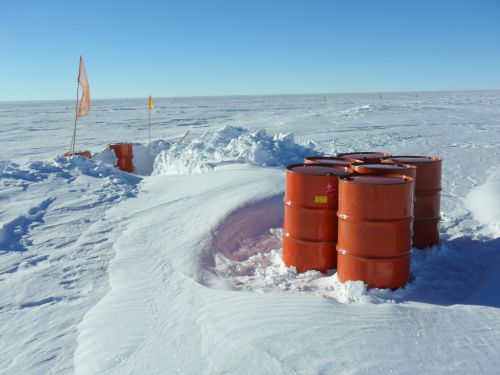
In addition to digging out fuel barrels, we started preparations for raising the AGO shelter. The first step to this was digging out the four guy wires that help stabilize the shelter during high wind conditions. This had to be done to ensure the wires were not curved underneath the snow pack once the shelter was raised.

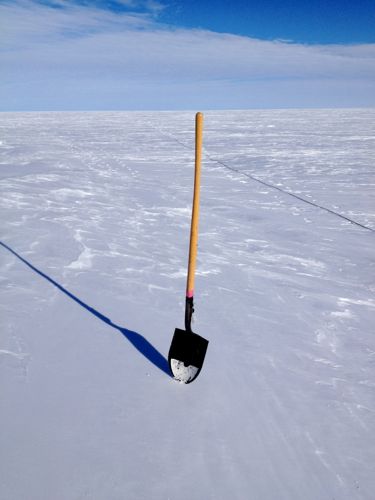
Day 3 - More preparation for the shelter raising.
Phase two of shelter raising required us to pack snow underneath the AGO, and create a snow burn for the shelter to sit on. The guy wires were removed and the shelter was lowered on to the snow. After that, we pulled each of the 4 posts out of the frozen snow using a winch and pulleys.

Took a break from our shelter raising to install a new antenna used to detect interactions between Earth's ionosphere and the sun. A lot of people may not realize it but the ionosphere is used by ham (amateur) radio operators to communicate with people around the world. They skip radio transmissions across the ionosphere and the signal is eventually reflected down to others listening on the ground below more than 1/2 way around the World. When the sun interacts with the ionosphere radio waves are generated, and those signals can be detected by radio antennas like the one we just installed at AGO 2.
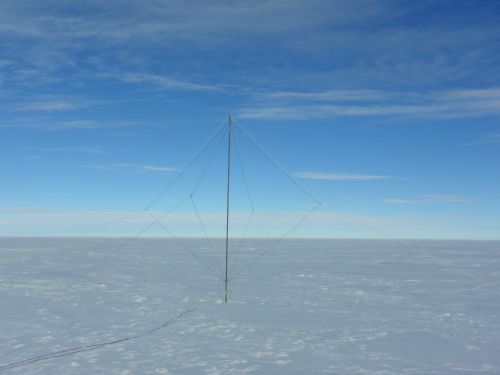

Day 4 - Raising the Shelter

The wind and snow drifting out here is pretty incredible. In order to keep pace with the weather, these shelters are typically raised every two or three years.
Here's some video from the AGO 2 site that provides a glimpse of what it's like to be out on the East Antarctic Plateau at site #2 of the Automatic Geophysical Observatories. - http://youtu.be/eAjhayBKaY8
Day 5 - Wrapping Up
Thanks to some great teamwork we were finishing up operations a day ahead of schedule. We called in and asked to return from the field a day early, and to our surprise the request was approved. This meant we had to be packed and ready to leave right around 10:00 AM the next morning.
While we had been working outside the past few days the power management and remote communication systems were being upgraded inside.

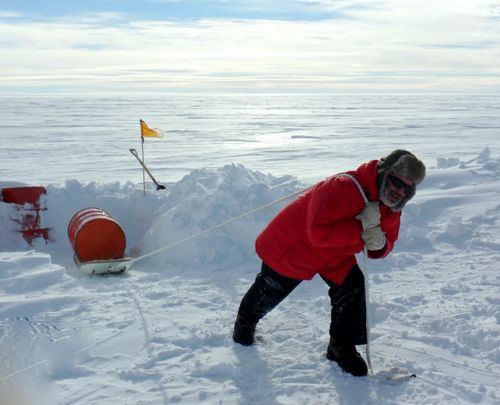
At the end of the day, we all got our personal gear in order anticipating a morning flight back to South Pole Station. I decided to cook and treat the group to steak burritos for dinner as a going away meal. Should have known better.
Day 6 - Go Back to Bed
I got up and took one look outside and knew we weren't going anywhere. It was cloudy and the snow was blowing. Usually for the pilots wind is not that much of a problem, but when the clouds come in we get what's called a white-on-white condition. The clouds are white and the snow is white and when that happens pilots can't distinguish where the sky ends and the ground begins. Under those conditions it's impossible to land safely.
Everyone had a late night getting ready for pick-up, so we all slept in until noon or so. Spent the rest of the day working on my computer, watching movies, writing post cards, and making water … always making water!
I made my way out to the Cargo Line earlier this afternoon to get stuff for dinner. Decided if we were going to be trapped I might as well make some good spaghetti sauce (the kind you let simmer for at least two hours) with hot sausage and cooked some tortellini to go with it.
Day 7 - More Waiting on the Horizon
So it's 12:30 AM on Tuesday December 11th and we are starting movie #2. The "Otter" was supposed to take us back to South Pole Station 14 hours ago, but low level clouds and drifting snow kept Bob, Andy, Marc, Gil, and I on the ground at AGO 2.
So the motto here in antarctica is hurry up and wait… and it looks like we'll likely be doing some more of that. It's 2:36 AM … movie 2 ended and the sky conditions actually look worse than they did yesterday.
Sure enough the morning brought another day of waiting. About 1:00 PM the clouds broke and Marc got on the radio to see if it was still possible to arrange a flight out, but no luck. We'd heard there might be a window open up for a short time, and then clouds were predicted to roll back in for several days. Mentally we were preparing for the worst and thinking the window could close by morning leaving us out on the ice for several more days.
The best thing I did all day was wash my hair … amazing how it changed my attitude. the small physical comforts that are absent can be missed immensely. In the time here where basic needs are primary and the static of the modern world are too distant to reach you, you realize some things.
You don't really need a shower every day.
Food is food … calories keep you warm and alive. It sure is nice to have food that tastes good, but it's not really necessary.
Outhouses (good old Mr. Scott) get the job done just fine. I remember visiting my Uncle Yunku (Ukrainian for John so I've been told) at my dad's family farm house. There was no indoor plumbing, and he lived there until the mid 80's when he passed away. My time here takes me back a bit to the visits to my uncle's home.
Baby wipes are a great invention! It's much better to have clean pits and a clean face and smell like a baby's bottom, than the alternative.
Big houses are way overrated. If 5 guys can learn to spend 8 hours a day in an 8' x 16' room, an outhouse, and individual 4' x 7' tents, a single family can surly make due with a small 2 bedroom house.
There is internal conflict as one tries to balance the need to communicate with others and the need for aloneness and privacy.
The value of a sense of humor can not be overestimated! Bob, Andy, Gil, Marc, and I have had vastly different life experiences, have significantly different beliefs when it comes to politics and religion. But something we all share is a sense of humor and mutual respect. It is a glue that hold people together in a challenging environment.
Hot drinks on a cold day are as beneficial to one's psychology as they are to one's physiology.
Society has given time its significance. In reality outside the constraints of formal society a time piece (watch) is not necessary. Native Americans have, and many today still hold this basic understanding. We could learn something from them.
Humans can and do adapt to the needs of their environment as much as their physiology and psychology permits.
Having "one" without it's authentic and True counterpart brings a lack of balance in the Universe. "Night" is just as beautiful and necessary as the "day".
Add a bit of peanut butter to Oreo cookies … tastes great!
Day #8 Going Home!
And I woke up to Andy knocking on my tent saying they were coming to get us. So opened up my tent to a beautiful sky with broken clouds. Rolled up my sleeping bag and packed the last few items in my bag, and starting working to break down camp.
And about fours hours later Phil and Dave … the Twin OtterA highly maneuverable utility aircraft developed by de Havilland Canada. It can be flown slowly and in tight circles, and is designed for 20 passengers, short takeoffs and landings, and often used for cargo, passengers, and as a science platform. pilots … landed to take us back to South Pole Station and a nice hot shower!
Check out the landing - http://youtu.be/ncOrVzG8TtM


Comments